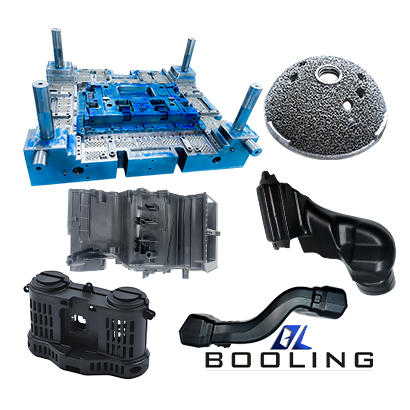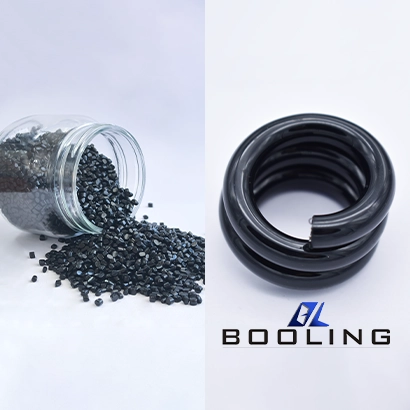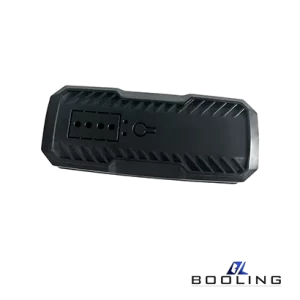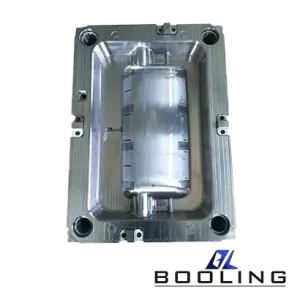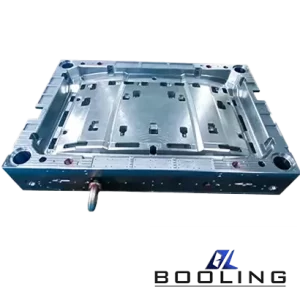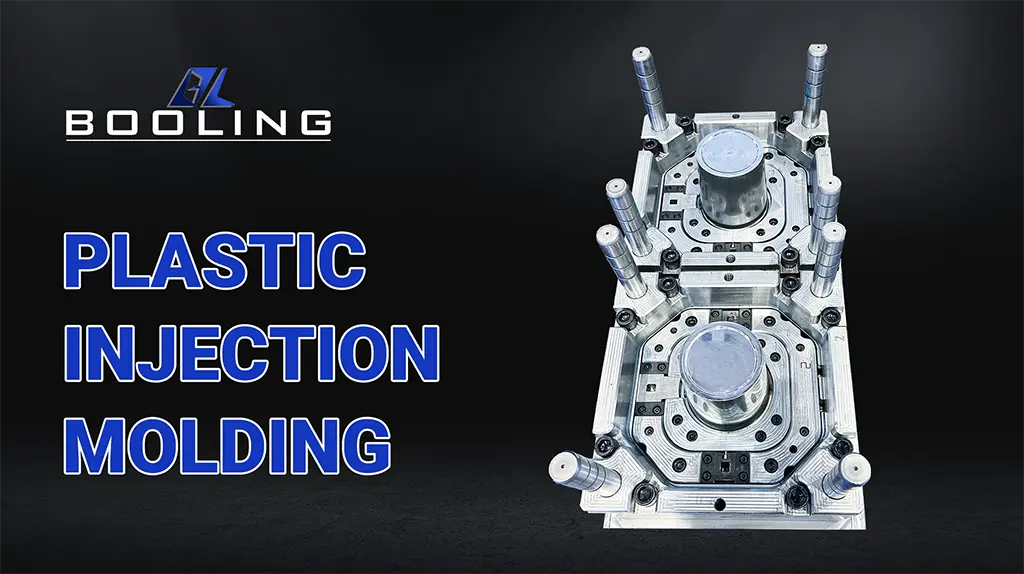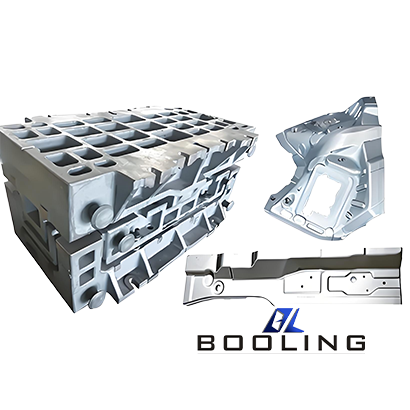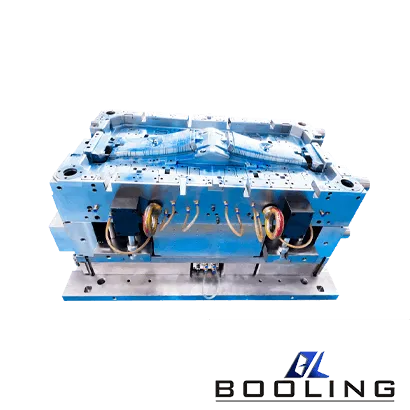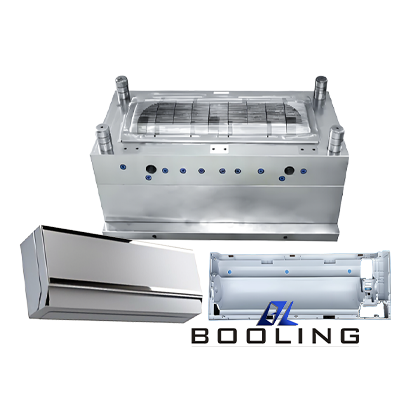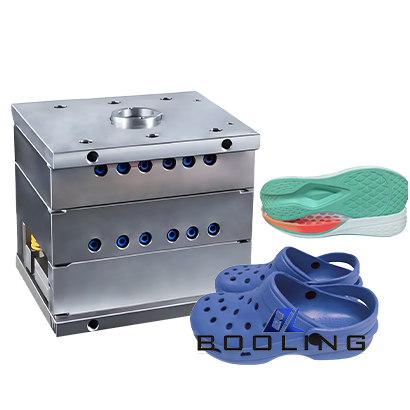Home > Four Technical Classifications of Injection Molds
Details
Details:
Model
Material
Brand
Origin
Application
Booling-Injection Mold-1
P20, 718, S136, 2738 etc
Booling
China
Home Appliance parts
Injection molding can be divided into ordinary injection molds, multi-color/two-color injection molds, gas-assisted injection molds, and micro-foaming injection molds according to the molding process. It is mainly used in automotive parts, home appliances, daily chemicals, electronic components, etc.
Advantages of injection molding:
- High strength and toughness
- Good transparency
- Extreme temperature resistance
- Chemical corrosion resistance
- High production efficiency
Related Hot Products
Conventional Injection Mold
The most basic and widely used type of injection molding mold. It utilizes a single plastic material to form one part in a single mold cavity per injection cycle.
Structure & Workflow:
-
Clamping: The moving and fixed mold halves close tightly under the injection machine’s pressure, forming a sealed cavity.
-
Injection: Molten plastic is injected through the machine’s screw/plunger, via the mold’s gating system (sprue, runners, gate), into the cavity.
-
Packing/Holding: After injection, pressure is maintained to compensate for material shrinkage during cooling, preventing sink marks and ensuring dimensional accuracy.
-
Cooling: The plastic solidifies within the cavity. The mold typically has cooling channels circulating coolant (water/oil) to accelerate cooling.
-
Mold Opening: The mold opens, the moving half retracts.
-
Ejection: The mold’s ejection system (ejector pins, ejector plate, etc.) pushes the solidified part off the core or out of the cavity.
-
Part Removal: The part is removed (manually or automatically).
-
Closing: The mold closes again, starting the next cycle.
Key Components:
-
Fixed Mold Half (attached to machine stationary platen)
-
Moving Mold Half (attached to machine moving platen)
-
Cavity (forms the part’s external shape)
-
Core (forms the part’s internal shape)
-
Gating System (channels guiding plastic into the cavity)
-
Cooling System (controls mold temperature)
-
Ejection System (removes the molded part)
-
Guiding Mechanism (ensures precise mold alignment)
-
Venting System (vents air and gases from the cavity)
Advantages:
-
Mature, widely applicable technology.
-
Relatively simple mold structure, shorter design/manufacturing lead time, lower cost.
-
High production efficiency, suitable for mass production.
-
Capable of forming complex shapes with high dimensional accuracy.
Disadvantages:
- Single material, cannot achieve multi-material/multi-color composite structures.
- Prone to sink marks, warpage in parts with uneven wall thickness.
- Material utilization is relatively lower compared to some special processes (e.g., gas assist, microcellular foam).
Typical Applications: Virtually all plastic product domains: consumer goods (buckets, bins, lids), appliance housings, electronic components, automotive interiors, toys, packaging containers.
Multi-Color / Two-Color Injection Mold
This technology allows two or more different colored or different performance plastics to be injected sequentially or simultaneously into different cavities or areas of a mold within a single cycle, producing a single part with color combinations, soft/hard combinations, functional zoning.
Core Principle: Utilizes rotational (rotary plate) or translational (sliding) mechanisms, or multiple independent core/cavity sets, to precisely move the first-shot molded portion (acting as an insert) within the mold to a second injection position for overmolding.
Main Types:
-
Rotary Plate Type: Features a rotating plate holding the first-shot core(s). After the first shot, the plate rotates (e.g., 180°), positioning the first-shot part into the second-shot cavity for overmolding. Most common type.
-
Sliding Core / Slide Type: Uses sliding core(s) or cavity slides. After the first shot, the slide moves, positioning the first-shot part for the second shot.
-
Core Retraction Type: After the first shot, part of the core retracts, creating space for the second shot.
-
Multiple Independent Cavity Sets: Contains multiple independent cavity sets, supplied by multiple injection units on a special machine or multiple machines.
Structure & Workflow (Rotary Plate Two-Color Example):
-
First Shot Clamping/Injection: Mold Section A closes; First material injected into first cavity set, forming Part 1.
-
First Shot Cooling/Opening: Mold opens; First-shot part remains on core(s) on the rotary plate.
-
Plate Rotation: Rotary plate rotates (e.g., 180°), moving the core(s) with Part 1 to the second-shot cavity position.
-
Second Shot Clamping/Injection: Mold Section B closes (Part 1 now acts as an insert); Second material injected, overmolding/combining with Part 1.
-
Overall Cooling/Opening: Mold opens.
-
Ejection/Part Removal: Ejection system ejects the complete multi-color part.
-
Plate Reset: Rotary plate rotates back to start position for next cycle.
Advantages:
-
Aesthetics: Achieves complex, seamless color patterns and decorative effects (e.g., two-color keys, light guides).
-
Functional Integration: Combines material properties (e.g., rigid base + soft grip, transparent + opaque areas).
-
Reduced Assembly: Integrates multiple parts into one, improving strength, eliminating gaps, lowering assembly cost.
-
Improved Sealing: Material bonding often provides better sealing than mechanical assembly.
-
Design Freedom: Creates unique visual and tactile effects.
Disadvantages:
-
Complex Mold: Significantly more complex structure requiring precise mechanisms; design/manufacturing cost greatly increased.
-
Specialized Equipment: Requires dedicated multi-color injection machines (at least two independent injection units).
-
High Material Compatibility Requirement: Materials must exhibit good adhesion and similar processing temperatures / shrinkage rates to prevent delamination or warpage.
-
Complex Process: Parameter setup/control (plate positioning, timing, injection sequence) is more complex.
-
Longer Development Cycle: Mold design and debugging take longer.
Typical Applications: Toothbrush handles (soft/hard), tool grips, automotive lamp lenses (transparent/opaque), keyboard keys (two-tone legends), lids with soft seals, multi-color toys, electronic housings with tactile zones.
Gas-Assisted Injection Molding (GAIM) Mold
A specialized technique introducing high-pressure inert gas (usually nitrogen) during conventional injection. After partially filling the cavity with plastic, gas is injected into the molten plastic core, using gas pressure to complete cavity filling and form internal hollow channels.
Core Principle: Utilizes gas penetrating the molten core and flowing towards paths of least resistance (typically thicker sections) to complete packing and shaping.
Workflow:
-
Short Shot: Inject a partial melt shot (approx. 70%-95% cavity volume).
-
Gas Injection: Inject high-pressure nitrogen into the melt core via gas nozzles/needles in the mold. Gas penetrates the core, pushing the melt front to fill cavity extremities.
-
Gas Packing: Gas expands, applying pressure to hold plastic against cavity walls, compensating for shrinkage, and forming hollow gas channels within thick sections.
-
Gas Venting: Release gas pressure after plastic solidifies.
-
Mold Opening/Ejection: Open mold, eject part.
Key Components (Added vs. Conventional Mold):
-
Gas Injection Unit: High-pressure nitrogen generator, precision pressure controller, gas injection valves.
-
Gas Nozzles/Needles: Installed in the mold for gas injection.
-
Gas Channel Design: Mold design must incorporate intended gas flow paths (channels), typically in thick sections or rib locations.
Advantages:
-
Significantly Reduces Sink Marks & Warpage: Uniform gas packing pressure eliminates surface defects from uneven walls.
-
Reduces Internal Stresses: Internal gas pressure counteracts shrinkage stresses; low part stress, better dimensional stability.
-
Saves Material (Weight Reduction): Hollows thick sections; saves 15%-40% raw material.
-
Increases Part Stiffness & Strength/Weight Ratio: Designed channels act like ribs, enhancing rigidity.
-
Shortens Cycle Time: Hollow structure reduces cooling time (less material, gas is insulating).
-
Reduces Clamping Force: Gas packing pressure is lower than conventional packing pressure.
-
Enables Larger, More Complex Thin-Wall Parts: Gas assist aids filling long flow paths.
Disadvantages:
-
Increased Mold Cost: Requires channel design and gas needle/nozzle installation.
-
Increased Equipment Cost: Requires additional high-precision GAIM equipment.
-
Complex Process Control: Highly critical control of short shot volume, gas injection timing, pressure, duration; difficult debugging.
-
Potential Surface Defects: Poor control can cause “fingering” (gas penetration marks in thin areas), needle marks, blow-through.
-
Part Design Limitations: Part structure must accommodate gas penetration, typically requiring thicker sections for channels.
Typical Applications: Large flat parts (TV bezels, furniture panels), thick-walled ribbed parts (car door handles, instrument panel supports, armrests), tubular/rod-like parts (chair legs, hangers), structural parts requiring high rigidity/low weight.
Microcellular Foam Injection Molding Mold
It dissolves supercritical fluid (SCF) homogeneously into the plastic melt. Upon injection into the mold, a rapid pressure drop causes the SCF to instantly gasify, forming a vast number (typically >10⁹/cm³) of extremely tiny bubbles (5-100 microns diameter), creating a uniform microcellular structure throughout the part.
Core Principle: Exploits the solubility of SCF in melt under high pressure and its rapid nucleation and expansion upon pressure drop.
Key Elements:
-
Supercritical Fluid (SCF): Most commonly supercritical nitrogen (scN₂) or supercritical carbon dioxide (scCO₂). Above critical temperature/pressure, they exhibit gas-like diffusivity and liquid-like solubility.
-
Precise Metering & Mixing: SCF is precisely metered and injected into the plasticating barrel, achieving homogeneous mixing via a specialized screw to form a single-phase melt/gas solution.
-
Rapid Pressure Drop: Injection into the mold cavity (lower pressure) triggers instantaneous, uniform nucleation.
-
Controlled Foaming: Mold temp, melt temp, injection speed tightly control bubble growth and stabilization.
Mold Characteristics (vs. Conventional Mold):
-
Enhanced Mold Temperature Control: Often requires higher mold temps (than conventional) to delay skin cooling, allowing gas diffusion for uniform cells and better surface finish.
-
Rapid Thermal Cycling: Sometimes uses variotherm (e.g., steam heating/cooling) to optimize surface quality.
-
Venting Design: Requires more efficient venting for the large gas volume generated.
-
Strength Requirements: Internal foaming pressure is lower, reducing clamping force demand, but mold rigidity is still essential.
Advantages:
-
Significant Weight Reduction: 5%-30% weight savings possible (application dependent).
-
Reduces Internal Stresses & Warpage: Microcellular structure effectively releases stresses; excellent dimensional stability and flatness.
-
Shortens Cycle Time: Microcells reduce thermal conductivity, shortening cooling; lower internal pressure enables faster mold opening.
-
Reduces Clamping Force: Foam filling requires lower pressure; clamping force reduced by up to 50% or more.
-
Saves Material Cost: Direct savings from weight reduction.
-
Improves Thermal/Acoustic Insulation: Closed-cell structure provides good insulation.
-
Faster Filling: Reduced melt viscosity improves flow for thin walls/complex geometries.
Disadvantages:
-
Surface Quality Challenges: Prone to surface defects like “swirl marks,” “silver streaks”; requires optimization/post-processing (variotherm, texture, painting) for high-gloss parts.
-
High Equipment Investment: Requires dedicated SCF metering, pressurization, and injection systems.
-
Narrow Process Window / Difficult Control: Extremely precise control of temp, pressure, speed, SCF concentration is critical.
-
Potentially Higher Mold Cost: Higher demands on mold temp control may require special systems.
-
Material Limitations: Not all plastics are suitable; material foaming behavior and final properties must be evaluated.
-
Changes in Mechanical Properties: Tensile strength, flexural modulus typically decrease with density (though specific strength may increase).
Typical Applications: Weight-sensitive parts requiring good dimensional stability, accepting surface texture or post-processing: Automotive interiors (door panels, trim), electronics housings, packaging, insulation/acoustic parts, thick structural parts, sporting goods, office furniture components.
Summary Comparison Table
| Feature | Conventional Injection Mold | Multi-Color/Two-Color Mold | Gas-Assisted Injection Mold (GAIM) | Microcellular Foam Mold |
|---|---|---|---|---|
| Primary Purpose | Basic Shaping | Multi-Material/Color Integration | Eliminate Sinks, Reduce Weight, Increase Rigidity | Weight Reduction, Reduce Stress, Shorten Cycle |
| Material(s) | Single Material | Two or More Materials/Colors | Single Material (Typically) | Single Material + Blowing Agent (SCF) |
| Internal Structure | Solid | Solid or Local Overmold | Hollow Channels in Thick Sections | Uniform Microcellular Structure |
| Key Advantages | Mature, Economical, Efficient, Universal | Aesthetics, Functional Integration, Reduced Assembly | Eliminates Sinks, Lowers Stress, Saves Material, Increases Rigidity | Significant Weight Reduction, Low Stress/Warp, Short Cycle |
| Key Disadvantages | Prone to Sinks/Warp, Single Material/Color | Expensive Tooling/Equipment, Complex Process, Material Limits | Complex Process, Potential Surface Defects, Design Limits | Surface Quality Issues, Expensive Equipment, Demanding Process |
| Mold Complexity | Low | Very High | Medium-High | Medium-High (Focus on Temp Control) |
| Equipment Requirement | Standard Machine | Dedicated Multi-Color Machine | Standard Machine + GAIM Unit | Standard Machine + GAIM Unit |
| Typical Applications | Vast Majority of Plastic Parts | Toothbrushes, Tool Grips, Lenses, Keys, Two-Tone Parts | Handles, Supports, Large Panels, Tubular Parts | Auto Interiors, Electronics Housings, Packaging, Thick Parts |
Automotive Mold Related Content
Applied’s expertise in modifying materials at atomic levels and on an ihdustrial scaleenables our customers to transform possibilities into reality.

